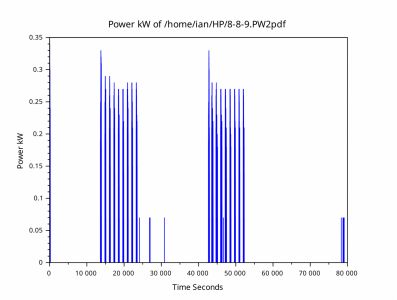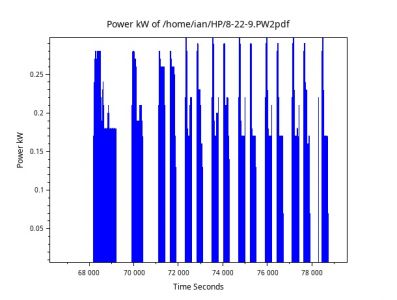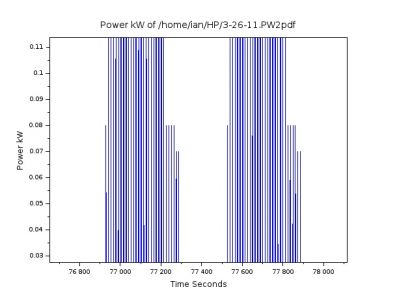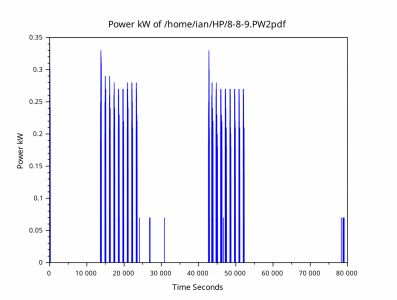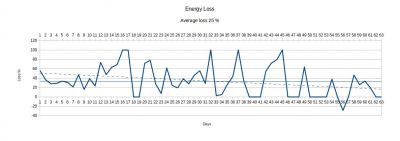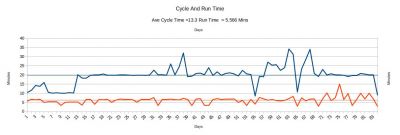Thermostat or Thermistor?
As with every other aspect of Heat Pumps I cannot compare my Thermostat with the Internal Thermistor.
Internal Thermistor
My internal Thermistor is attached at the back of the LCD Screen .
The LCD screen is attached to my Hot Water Tank .
My Hot Water Tank is positioned within my kitchen.
My Hot Water tank is located at the back Kitchen Door facing due South into the Summer Sun.
The outdoor temperature displayed on the LCD panel can be widely different from the Temperature of my Living Room.
My internal thermistor is prone to noise , producing E121 errors.
I can buy an external Thermistor kit MRW-TA complete with a 12 M cable,
https://midsummerwholesale.co.uk/buy/samsung-heat-pumps/Remote-Temperature-Sensor-MRW-TA.
I am , however , skeptical about a simple Thermistor sensor attached to a 12 long unsheathed, cable.
Does anybody have any experience of the MRW-TA. ?
Recommended by several , including a visiting French Samsung Engineer, I remain sceptical ..
Honeywell home Thermostat
My Honeywell home exactly measures and controls the Living room Temperature.
My Honeywell Thermostat , can provide a stable, and recommended (DECC 2012) Cycle Time of 20 minutes:
The Cycle Time is exactly that of the Honeywell home 20 minutes setting.
The Honeywell home issues a simple Pulse Width Modulated signal using a simple output switch.
The output "signal " consists of a Variable width "Run Time " otherwise the "Compressor Demand signal. The Run time , aka Compressor demand is , on average 6 ..8 minutes in duration.
The Run Time or Compressor demand signal is followed by the "Evaporator Time".
The Honeywell home , when stable at the set Temperature , ensures that the Compressor Time plus the Evaporator time equals the Cycle Time , here 20 minutes.
Compressor Time + Evaporator time = Cycle Time.
Stability is only maintained at the set temperature, outwith the set Temperature the Honeywell home issues :
Note the unstable Cycle Time, here set by a Honeywell home Set Temperature of 25 C with the room Temperature being controlled by the Weather compensation , Water law display screen.
The Room Temperature was controlled, but a unstable, varying between 21.5 and 23 C.
The purpose of this experiment was to allow the System to be only controlled by the Weather compensation system , not the Thermostat .
So, my conclusion , somewhat different my previous conclusion is that:
Left undisturbed, the Honeywell home does provide a good control Thermostat for the Samsung .
Honeywell Thermostat or internal Thermistor ?
As of NOW, 24/08/2024 , I will continue to use the Honeywell home .
However, I will keep my options open and purchase a MRW-TA kit and a MIM-B19N Mod-bus interface for my Samsung.
I do, as Oliver Cromwell said to the General assembly, in Edinburgh , in 1651 , "think it possible that I could be wrong".
Yes @jamespa you are again correct ,The Honeywell home does allow the maximum Temperature to be increased to 25 C.
But , with the instability shown above I will not be increasing the Set Temperature to 35 C.
shorting Compressor ?
Given that the Run Time pulse from the Thermostat is responsible for the Compressor Run Time , should I "short the Thermostat Switch output" ?
A long compressor demand resulting from shorting the Compressor would "cause permanent and irreversible damage" to the Heat Pump ?
Apparently, Heat Pumps , like all refrigerators need to Cycle !
Heat Pumps must , apparently be allowed time to evaporate during a cycle.
Thank you for the extensive commentary, albeit I don't think it contains a direct reply to the question asked (possibly there is an implied reply, but I cant be sure).
As you appear to be determined to pursue your own route and logic to solve this (and likely spend money unwisely, despite your frequent complaints about cost), I will not comment further. That is of course your prerogative, however it would perhaps have been helpful if you had declared early on that this was your intent, so that I (and others) did not waste quite so much of our time in a futile attempt to help.
I wish you luck in getting your installation to work satisfactorily and will now be unsubscribing from this thread.
4kW peak of solar PV since 2011; EV and a 1930s house which has been partially renovated to improve its efficiency. 7kW Vaillant heat pump.
MRW-TA external Thermistor:
Hi mike,
1) I can easily force the Secondary motor to be permanently ON.
However, I gather that forcing any Refrigeration system permanently ON may force the compressor permanently ON, interfering with the Refrigeration cycle.
My understanding was that my current Honeywell Thermostat produced a variable pulse width RUN Compressor signal.
Does fv 2091 set to 0 disable the Compressor Run on the Thermostat input ?
2) is the MRW-TA external Thermistor better than the internal Thermistor?
My internal Sensor produces E121 errors intermittently. A visiting FRench Samsung Engineer disabled the External Terminal to the External Sensor "to reduce noise".
Sorry , again for asking , apparently stupid Questions.
I suspect that you are getting a little confused.
You should think of the input from the room thermostat as an 'enable' signal rather than a 'run' signal. When the room thermostat is calling for heat, the heat pump is therefore enabled to run, whether the heat pump compressor runs or not will be dependent upon the LWT and WC settings. When the LWT reaches the upper limit the compressor will be stopped even though the room thermostat is still calling for heat. The arrangement is a logical AND not a logical OR.
When you carried out the test with the room thermostat set to a high value, if the room temperature increased then that would indicate that the WC settings were incorrect and require adjustment.
Enable or Compressor control?
hi @derek--m
Could you please look at a graph of the power consumption of my Samsung Heat Pump earlier this year?
I interpret this graph as showing The Time between Pulse as exactly 10 minutes or 600 Seconds apart.
I also interpret the Pulse widths themselves as being 6.3 minutes or 380 seconds wide.
My Thermostat was then set for a 10 minute Cycle time.
It appears that my Thermostat is producing a variable Pulse width modulated Run Demand , here 6.3 minutes wide.
I am probably mistaken , or , is my Thermostat generating a Run Demand such that the resulting Cycle Time is exactly 10 minutes.? The Cycle time being found from the cooling, or Evaporator time?
The Run signal conceptually seems identical to the Compressor Power demand.
The Evaporator time seems conceptually and factually identical to the gap between the Power pulses.
My Thermostat was then set for a 10 minute Cycle time.
Am I mistaken , or , is my Thermostat "clever Enough " to vary the Run time pulse width until a cycle time of 10 minutes is produced by the Heat Pump?
My question is , if the Run time pulse is an active and variable input should I short it , resulting in a continuous Compressor ON condition?
I have been told that a continuous Compressor demand is not advisable on refrigeration systems , and , may "result in irreparable damage ".
many thanks in advance
I am not trying to annoy .......
Let me try to clear some of the confusion.
For the compressor to operate the heat pump requires two inputs, one from your room thermostat and one from the heat pump controller in the form of 'LWT not too high'.
So your 10 minute cycle is created by the room thermostat requesting heat, and because the LWT is below the upper limit, the compressor is started. The LWT starts to increase, but before it reaches the upper limit the room thermostat removes the 'enable' signal and the compressor is stopped. The running of the heat pump is therefore being controlled by the room thermostat on a 10 minute cycle.
If the room thermostat supplied a permanent enable signal, the compressor would run until the LWT reached the upper limit and the heat pump would then stop producing thermal energy until the LWT cooled to the lower limit. The heat pump is now being controlled by the heat pump controller.
You seem to be confused with regard to the operation of the Evaporator. Whenever the refrigerant gas is being circulated around the internals of the heat pump, the Evaporator is always in operation, otherwise the compressor would soon run out of refrigerant gas to compress. The condensed (liquid) refrigerant gas is passed by the control valve from the Condenser into the Evaporator, and in the process the pressure is reduced and the refrigerant gas starts to change state from a liquid into a gas. For this process to complete the refrigerant gas needs to absorb thermal energy, which it does so from the outside air. When the compressor stops, the remaining gas in the Condenser continues to condense and flow to the Evaporator, until the temperatures and pressures reach equilibrium.
What you describe as the 'Evaporator time' is actually a time delay calculated by the room thermostat and has nothing to do with the Evaporator.
MCS is a charity .............they are educating You!
Hi, @johnmacleod10
Nice to hear someone else has the same or similar problems.
MCS & NIC support ?
The MCS and the NIC have Struck OFF my installer three times over the last two years of my Heat pump saga.
I would NOT rely on either the MCS or the NIC to provide any help.
After two years the NIC withdrew from my case saying that " because your former "installer " has refused to repair your Heat Pump ........
" I know that you are Not going to like this .............................but Nothing can be now be Done !"
One point that is often missed is the dtatus of both the MCS and the NIC:
"Both the MCS and the NIC are Charities "
When asked to explain "How the MCS could conceivably be a charity ?"
I was informed that the MCS fulfills it's charitable status by "Educating the General Public in Energy Saving and climate change !"
RECC ?
The RECC has NOW been taken over by the well known charity .....................the MCS.
In my experience , using the RECC repeatedly over the last two years ......................" the RECC are, or I should were !, far better than the MCS !
However, at the end of the day , after several visits to the RECC I was passed right back to the same officer , stiing at the same desk within the NIC !!
So, the RECC were very good ........................but have been subsumed into the MCS Charity .
Scottish Government, MSP,EST,and HES.
Because my "installer " failed to Commission my Heat Pump I was without certification.
Without certification I could not "initially " claim any repayment Grants or loans.
After several months of relentless complaints my MSP , EST and the HES arranged a partial repayment of my initial outlay.
However , my continued complaints "could only be handled with a return to the same "officer "",sitting behind the same desk, in the NIC !!
The bottom line is john , None will , in reality help!.
Remember the MCS is a charity .............they are educating You!
DO I have a fault at all?
HI @derek-m ,
An excellent description clarifying my understanding .
However , my Heat Pump is apparently consuming power with a Run Time and a Cycle time of exactly 20 minutes , on 8thh Aug 24 :
Would I be wrong in describing the apparent "short Cycling " as being the result of Running the compressor for ~8 minutes followed by a Evaporator only period of ~12 minutes giving a total cycle period of exactly 20 minutes.
All Heat pumps are no more than glorified Refrigerators and must Cycle !
If Power were measured with the same resolution , would not all Heat Pumps display the same "Short Cycling"!
Do I have a Cycling fault at all?
If the Power was measured on other Heat Pumps with the same resolution would not all "Heat Pumps apparently display "Short Cycling" ?.
Do I Really have losses far worse than other Heat Pumps?
I am in a tiny minority in having a water power "Sharky " meter fitted to the Start of the Radiator water circuit.
All manufacturers and all "installers" relentlessly quote the COP .
However , the COP is measured at the Heat Pump output itself.
My Sharky measures the REAL COP at the start of the Radiator circuit.
Again , Do I lose too much energy or not ?
Again, do I have another problem generated by over measurement?
Energy Reflection and Delta T ?
If Heat pump delivers water at about 35 C and returns water at 30 C , i.e a Delta T of 5 C is theis not a vast waste of energy by reflection ?
All electricians and radio Hams are familiar with the concept of REAL and IMAGINARY Energy Components in Electrical Transmission.
Electricians give the REAL power in kW and the reflected power in VA kW .
Water supplied energy , however gives the Energy reflected in Delta _t .
The Delta_t figures for water energy supply systems are therefore .....................difficult to defend!
Why not therefore AIR to AIR Heat PUMPS ......
Why not air to Electricity Heat Pumps, Electricity is far easier, and more efficient to transmit than Water
I'm afraid most of what you have recently posted is a load of drivel. The problems with your system have been repeatedly explained over the past two years, so I suggest that you read back through the thread.
To answer your questions.
At a frequency of 3 times per hour your heat pump is NOT short cycling, so please stop stating that it is.
Heat pumps do not cycle if they have sufficient heating demand, the cycling on your system is being caused by the thermostat.
Your reference to real and imaginary power in electrical circuits has nothing whatsoever to do with heat pumps, the fact that the RWT is lower than the LWT means that thermal energy is being transferred from the water to the heat emitters.
There are Air to Air heat pumps, they are often described as Air Conditioning.
I would be interested to know how you could produce electricity from air.
If you wish to get your heat pump operating in a more efficient manner then you must answer forum member's questions when they are asked, and not do a 'Monty Python' by going off at a tangent on something that has nothing to do with the original question asked.
The ball is now in your court, forum members are willing to provide free relevant advice, but only if you are willing to take such advice. Failure to do so would indicate that you are a 'forlorn hope'.
Run and Cycling times.
My understanding , taken from the DECC Report on cycling in 2012 , is :
8
Recommendations
Both ASHPs and GSHPs should be designed for a minimum run time of circa six
minutes, which will avoid the worst excesses of detrimental performance caused by
short cycling;
Ideally, systems should be designed for slightly higher run times than this – for the
particular GSHP system used here there appears to be an optimum performance at
around 10 to 15 minutes, whilst run times of ~ 8 minutes for the ASHP gave COP
values close to catalogue steady state values;
Explore all options to achieve these minimum run times including:
o Zoning to ensure sufficient radiator surface is available at all times (as was
achieved here by using the lounge / dining room as the reference zone,
although a room thermostat override or wide switching band thermostat would
also be required to avoid room thermostat induced short cycling);
o Buffer tanks;
The 4-pipe buffer tanks arrangement tested here shows a promising method of
achieving the required minimum run times without the need for excessive volumes
(roughly 8 litres / kW heat output was used here);
o Ideally the 4-pipe buffer tank would be designed to achieved a high degree of
stratification so as to maintain flow temperatures to the CH system throughout
the heat pump off periods;
o Care needs to be taken in setting-up a 4-pipe buffer tank system to ensure
that the flows through the heat pump and through the fully open CH system
are well matched.
My Run and Cycle times are :
The DECC Recommendation for Air sourced Heat Pumps is that Run times do not , on average, have a period of Less than 6 minutes.
My average Run Time is , currently , 6.52 Minutes with Standard Deviation of 1.79. 6.52 +/- 1.79 .
My RUN TIME is , however, with a Standard Deviation of 1.79 ,.............................i.e. often less than 5 minutes!
The DECC Recommendation for Air sourced Heat Pumps is that Cycle times Should , on average, have a period of between twenty and Thirty Minutes.
My average Run Time is , currently , 21.52 Minutes with a Standard deviation of 6.25. 21.52 +/- 6.25.
*************************************************************
My Heat Pump is NOT , Currently , "Short cycling" following the DECC Definitions and Recommendations.
**********************************************************
*********************************************************
Before I discovered that the Maximum Cycle Time was set by my Honeywell Thermostat to 10 minutes, my Average time Cycle time was 8.5 minutes with a Run Time of 4.5 minutes, was
, then , "short cycling".
Using the DECC definition and recommended of Short Cycling!
*************************************************************
With a average cycle time of , currently , 21.42 and a Std dev of 6.25 my Heat Pump is NOT Short Cycling.
With an average Run Time of , currently , 6.85 and a Std dev of 1.79 my Heat Pump IS , by the DECC Definition, often Short Cycling, .
I am still waiting on any response, from any Plumber , about rebuilding my Heat Pump following the your, @jamesPa et al instructions!.
I will Not be able to afford further costs following my , so far, outlay of > £14000!
Given the financial pressure , I am , not surprised , by your "drivel", or "Monty Pythonesque " description of my posts.
I am still , and must be , very sceptical about conflicting "advice ".!
Your advice is appreciated .............but.....................I , must , and will, return to my Scottish Skepticism!
This is not , so far, Twitter, X !!
I'm afraid that your heat pump will continue to operate as you have described until you replace or remove the Honeywell thermostat. If you decide to do so then please feel free to come back to the forum for further help and advice.
- 26 Forums
- 2,342 Topics
- 53 K Posts
- 256 Online
- 6,000 Members
Join Us!
Worth Watching
Latest Posts
-
RE: Setback savings - fact or fiction?
Hi @cathoderay - this is a good discussion! I feel like...
By RobS , 24 minutes ago
-

RE: Free Ecoheat Heat Pump Install
@deltona happy to help as much as I can if you decide t...
By bontwoody , 59 minutes ago
-

RE: Are We Sleepwalking Into Another Race to the Bottom?
I'll be honest, I love that idea! I'll start working on...
By Mars , 1 hour ago
-
-
RE: Configuring third party dongle for Ecodan local control
@majordennisbloodnok I think the HPDHD diagnosis may be...
By Sheriff Fatman , 3 hours ago
-

RE: External pipework insulation
I don't think we can tell from a photo whether your exi...
By Transparent , 3 hours ago
-
RE: Octopus Cosy Heat Pump Owners & Discussion Thread
I just found this forum after watching the YouTube vids...
By HarrisonC , 6 hours ago
-
Advice on internal circulation pump noise
Hi all - I wanted to share my recent experience of a do...
By jtg , 9 hours ago
-
RE: Controlling Daikin Altherma via P1P2 and Home Assistant
@majordennisbloodnok That’s correct. I can’t find anywh...
By weoleyric , 9 hours ago
-

RE: A Smarter Smart Controller from Homely?
@papahuhu I hope you get a swift resolution. Regards, T...
By Toodles , 1 day ago
-

RE: Poll for Time of Use, tariffs, technology
That’s fine by me too Major, I feel it is a sad reflect...
By Toodles , 1 day ago
-

Bingo. Sometimes a judiciously placed size 10 bovver bo...
By Majordennisbloodnok , 1 day ago
-
RE: Mitsubishi Ecodan 11.2kW heat pump with low COP
@ciocoiu-alexandru I can't provide the same level of di...
By Sheriff Fatman , 1 day ago
-

The three technical issues I'm considering are: BMS...
By Transparent , 1 day ago
-
RE: LiFePO4 lithium battery fires and explosions
@transparent Your post may fit better in th...
By Batpred , 1 day ago
-

RE: British Gas vs Octopus Energy vs Heat Geek vs EDF vs Aira vs OVO vs EON.Next vs Boxt
@jamespawhite, if you could be bothered, you could also...
By Mars , 2 days ago
-
RE: Commencing on an ASHP Installation Process
I've got a bit of time to draft something today, so the...
By Sheriff Fatman , 2 days ago
-
RE: Help with heat pump sizing
@amin I dont think materially relative to t...
By JamesPa , 2 days ago

